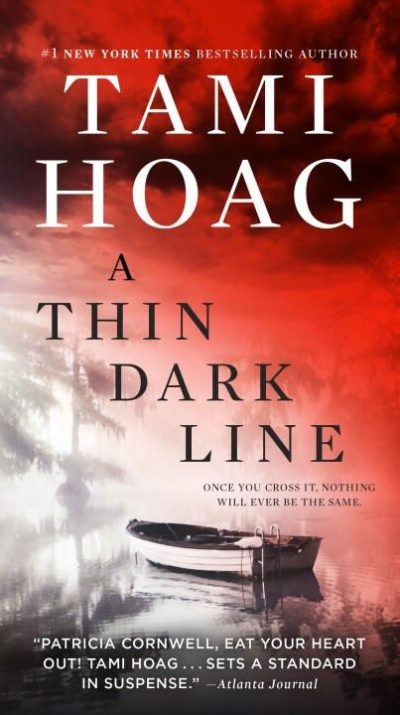Literary rating: ★★★★★
Kick-butt quotient: ☆☆
 This is officially characterized (though not in the cover copy) as the fourth book of the author’s Doucet series. However, that nominal “series” is apparently very loosely connected, only by having main or other characters from the fictional Doucet clan; and a Doucet appears in this novel, though not as the protagonist. Our protagonists are sheriff’s deputies Nick Fourcade, a detective, and Annie Broussard, a uniformed deputy who’d like to be a detective. (The book is also counted as the opener of the Broussard and Fourcade series, which is apparently more connected; but it has a resolution to the mysteries involved in this volume, while leaving things open for new ones.)
This is officially characterized (though not in the cover copy) as the fourth book of the author’s Doucet series. However, that nominal “series” is apparently very loosely connected, only by having main or other characters from the fictional Doucet clan; and a Doucet appears in this novel, though not as the protagonist. Our protagonists are sheriff’s deputies Nick Fourcade, a detective, and Annie Broussard, a uniformed deputy who’d like to be a detective. (The book is also counted as the opener of the Broussard and Fourcade series, which is apparently more connected; but it has a resolution to the mysteries involved in this volume, while leaving things open for new ones.)
Back in the late 80s, I visited the rural Cajun country of south Louisiana, where this book is set. So I could visualize the scenery, hear the accents and dialect, and appreciate the immersive evocation of place and culture that Hoag conjures, with references to things like zydeco music. (Hoag herself was born in Iowa and lives in Florida; but she’s clearly very familiar with this area, and has frequently set her fiction here.) The plot is very taut, respecting all of Aristotle’s classical unities; it unfolds over a period of about two weeks leading up to Mardi Gras and Ash Wednesday (a season which is a big deal in heavily Catholic south Louisiana) mostly in and around the small town of Bayou Breaux, population around 7,000. As the book opens, we learn that one Marcus Renard has just been set free on a technicality after being arrested by the sheriff’s office for the hideously savage rape and murder of a prominent local businesswoman. (The authorities are certain he’s guilty –but is he?) Soon after, the community begins to be terrorized by a serial rapist.
Like all serious fiction, this novel is fundamentally concerned with moral issues, the answers to which aren’t obvious and force readers to think. Here, the issues particularly revolve around the relationship of law and justice, and the ethics of vigilantism. (Personally, my view of the latter is more nuanced and less unconditionally condemning than some people’s; but Hoag forces us to consider the dangers of too facile a resort to extra-legal vengeance, and the valid reasons why our and other civilized legal systems provide safeguards for the accused.) The solution to the crime(s) is anything but obvious; early on, I was 100% convinced of the identity of the killer, only to change my theory much nearer the end to another solution I was equally certain of –only to be wrong both times. I was totally blindsided by the denouement. But this isn’t just an intellectual puzzle; it’s a story about vividly-drawn, three-dimensional people and their interactions.
This can be a very dark novel (and I’m told that’s often characteristic of Hoag’s work). The murder and rapes themselves aren’t directly described; and the sufferings of the victims, and the gory details of the crime scenes, aren’t alluded to more than they actually have to be. But while the average modern American doesn’t have any real sense that genuine moral evil is a reality which he or she could ever have any need to take into account, Hoag clearly has a very lively sense of that reality, and she doesn’t intend to let us close the book without sharing it. (That’s not a bad authorial aim!) Disgust would be a healthy reaction to the sexist and lewd attitudes of many of the male cops, and readers might want a barf bag handy when perusing some of the comments from these characters. (Hoag isn’t presenting these as role models; disgust is the reaction she wants there.)
Action heroine fans should take note that, though the cover copy doesn’t stress this aspect, Annie packs heat, and her police training has given her skills in hand-to-hand combat and using firearms –which just might turn out to come in handy. (And fans of action heroes will appreciate the fact that while Nick isn’t Superman, he can take care of himself very well in a fair fight.)
Since I’m trying not to get drawn into another open-ended series right now, I’m not planning to pursue this one. But I’d definitely recommend Hoag as a serious mystery writer, and I’d be open to reading more of her work sometime.
Note: While it’s not a romance, the book does have two instances (in 590 pages) of explicit unmarried sex. There’s also a certain amount of bad language, including f-words, much of it reflecting the real-life tendency of this kind of speech to be a feature of cop culture.
Author: Tami Hoag
Publisher: Bantam, available through Amazon, both for Kindle and as a printed book.
A version of this review previously appeared on Goodreads.




